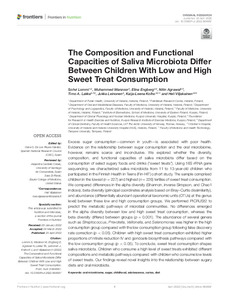The Composition and Functional Capacities of Saliva Microbiota Differ Between Children With Low and High Sweet Treat Consumption
Lommi, Sohvi; Manzoor, Muhammed; Engberg, Elina; Agrawal, Nitin; Lakka, Timo A.; Leinonen, Jukka; Kolho, Kaija-Leena; Viljakainen, Heli (2022-04-25)
Lommi, Sohvi
Manzoor, Muhammed
Engberg, Elina
Agrawal, Nitin
Lakka, Timo A.
Leinonen, Jukka
Kolho, Kaija-Leena
Viljakainen, Heli
25.04.2022
864687
Julkaisun pysyvä osoite on
https://urn.fi/URN:NBN:fi:tuni-202206025426
https://urn.fi/URN:NBN:fi:tuni-202206025426
Kuvaus
Peer reviewed
Tiivistelmä
Excess sugar consumption—common in youth—is associated with poor health. Evidence on the relationship between sugar consumption and the oral microbiome, however, remains scarce and inconclusive. We explored whether the diversity, composition, and functional capacities of saliva microbiota differ based on the consumption of select sugary foods and drinks (“sweet treats”). Using 16S rRNA gene sequencing, we characterized saliva microbiota from 11 to 13-year-old children who participated in the Finnish Health in Teens (Fin-HIT) cohort study. The sample comprised children in the lowest (n = 227) and highest (n = 226) tertiles of sweet treat consumption. We compared differences in the alpha diversity (Shannon, inverse Simpson, and Chao1 indices), beta diversity (principal coordinates analysis based on Bray–Curtis dissimilarity), and abundance (differentially abundant operational taxonomic units (OTUs) at the genus level) between these low and high consumption groups. We performed PICRUSt2 to predict the metabolic pathways of microbial communities. No differences emerged in the alpha diversity between low and high sweet treat consumption, whereas the beta diversity differed between groups (p = 0.001). The abundance of several genera such as Streptococcus, Prevotella, Veillonella, and Selenomonas was higher in the high consumption group compared with the low consumption group following false discovery rate correction (p < 0.05). Children with high sweet treat consumption exhibited higher proportions of nitrate reduction IV and gondoate biosynthesis pathways compared with the low consumption group (p < 0.05). To conclude, sweet treat consumption shapes saliva microbiota. Children who consume a high level of sweet treats exhibited different compositions and metabolic pathways compared with children who consume low levels of sweet treats. Our findings reveal novel insights into the relationship between sugary diets and oral microbiota.
Kokoelmat
- TUNICRIS-julkaisut [16882]
